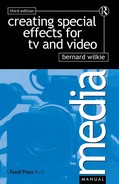Explosives
Gunpowder (or ‘black powder’) is a pyrotechnic mixture which burns at an extremely fast rate. This rate increases under pressure so that, when confined, gunpowder literally explodes. This is known as a deflagration.
The more powerful high-explosive materials are said to detonate, which is a different effect altogether and is brought about by the de-stabilisation of molecular structures. High explosives do not need to be confined, nor do they respond to initiation by fire. They must be triggered by small devices called detonators, which deliver a powerful shock setting off the process of de-stabilisation.
Their use
The majority of war scenes recorded outdoors rely on pyrotechnics for their explosions. However, there are occasions when something more powerful is required, and this is when high explosives are employed. Examples would include a huge underwater eruption to simulate the detonation of a sea-mine, the impact of a torpedo, a boat which had to be blown up on water, or, on land, a real building which had to be totally demolished.
Some ground effects can benefit from the use of high-explosive materials, as these give a sharper impact than pyrotechnics. An aerial attack with missiles might come into this category.
High explosives have other uses. An effects expert would have little choice but to use them when faced with the problem of blowing a branch from a tree or demolishing a number of wooden supports to drop a bridge.
The suppliers of these materials publish specifications and instructions which can be obtained on request, but all users in the entertainment industry must be fully trained and must hold both a certificate of competence and a valid user licence.
Types
High explosives for film use come in several varieties. Some are in the form of loose material, and others resemble putty, but one of the most useful for smaller effects comes as a reel of cord which can be cut into lengths. All require their appropriate detonators.
Regulations
Quite obviously, stringent regulations govern the purchase, use and storage of these materials. People who need them for TV or moviemaking purposes are advised to consult both the appropriate licensing authority and the local police.
Accidents seldom happen without human participation; they result from carelessness or diminished concentration.
DO ensure that all containers of explosive or incendiary materials are kept covered at all timed.
DON’T make up large amounts of material nor work with anything but the minimum of ingredients.
DO ensure that unused, non stock, Items are destroyed at the end of a programme.
DON’T destroy by ignition. Gunpowder and flashpowder should be neutralised in water.
DO wear protective goggles when working with explosives.
DON’T connect anything to wires before ensuring that they are disconnected from any form of power supply.
DO rehearse dangerous effects and check results before using them near people.
DON’T hurry or take chances. Don’t revise explosive or fire effects without further rehearsal.
DO expect the unexpected.
EXPLOSIVES
